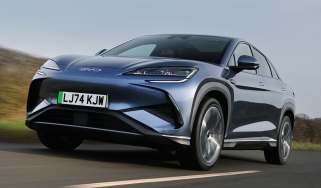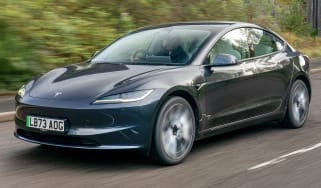Tesla Autopilot and Full-Self Driving explained: is it worth it in the UK?
We break down Tesla’s Autopilot system and whether it’s safe and worth your money
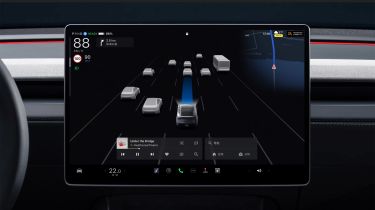
Tesla Autopilot has become one of the most talked-about features in the automotive world, offering a glimpse into the future of driving with its suite of advanced driving assistance features. It’s a technology that’s certainly pushed the industry closer towards a fully-autonomous future, but it hasn’t been without controversy – especially regarding its ‘self-driving’ capabilities and safety.
Introduced in 2014, Tesla Autopilot began as a relatively simple system offering lane-keeping assistance and adaptive cruise control. However, through Tesla’s innovative over-the-air updates, it has grown more sophisticated over the years. Today, there are three versions of the system: standard Autopilot, Enhanced Autopilot, and Full Self-Driving (FSD).
The standard Autopilot, included with all new Teslas, provides essential features such as traffic-aware cruise control and lane-keeping assistance. Enhanced Autopilot, available as an upgrade, adds extra perks like automatic lane changes, auto park, and the ability to summon your car remotely. Full Self-Driving promises even more advanced features, including navigating city streets, recognising traffic signals, and stopping for stop signs. However, many of these capabilities are still in ‘beta’ development, require active driver oversight and come with a list of limitations.
As the UK government invests further into the development of autonomous vehicles, many believe that self-driving cars are just around the corner. While that may be true, the reality is that you can’t visit your local car dealer and buy one today. However, systems like Tesla Autopilot are the closest thing we have right now, and can help to reduce fatigue over long journeys. Read on to find out how the system works, its limitations and safety concerns, and whether it’s worth the money.
What is Tesla Autopilot?
Tesla Autopilot is the name given to its suite of advanced driving assistance features. It’s probably just as important to clear up what Tesla Autopilot isn’t: it’s not a fully-autonomous driving system, at least not yet. Even the most advanced Full-Self Driving Autopilot package can’t take you to your destination with zero driver input – it’s still a driving ‘assistance’ feature after all.
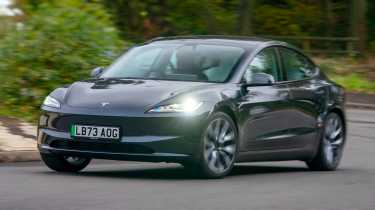
Every new Tesla comes fitted with Basic Autopilot. This system consists of adaptive cruise control, lane-keeping assistance, emergency braking and blind-spot monitoring. The car can keep in its lane on the motorway, adapt its speed to match the vehicle in front and avoid causing a collision, but no more than that. Like all Autopilot versions, the driver is required to keep their eyes on the road and hands on the wheel at all times.
Many new cars come fitted with a similar suite of assistance features, just branded under different names and usually as an optional extra. For example, BMW offers the 3 Series with its Driving Assistant Professional package, which also includes adaptive cruise control and lane-keeping assistance.
What about Enhanced Autopilot?
Enhanced Autopilot adds the ability to change lanes automatically, using the car’s sensors to note where surrounding cars are and the speeds they’re travelling at. It also includes an ‘Autopark’ function that enables the car to park itself, although official guidance says to override the system if needed by grabbing the steering wheel, meaning you should be inside the car at the time.
The ‘Summon’ feature is also an interesting addition, allowing you to press a button on the key fob to move your Tesla forward or backward out of a parking space. ‘Smart Summon’ takes this further, allowing the car to drive slowly around a car park to collect you at a determined point, for example at a supermarket entrance while you’re shielding from the rain. However, UK laws state that you should be no more than six metres away from the car when using this feature, and you could still be responsible if it causes an accident.
What is Tesla Full Self-Driving?
Don’t be fooled by the name – Tesla Full-Self Driving isn’t a fully autonomous system. The package comes with everything offered by ‘Autopilot’ and ‘Enhanced Autopilot’ but also has traffic light and stop sign recognition. Be aware that this feature is in the ‘beta’ stage, meaning it’s still awaiting improvements. Tesla warns that your car may not stop for every traffic signal at this stage and you must be ready to intervene.
‘Autosteer’ has been promised as a future update; this is a feature that will allow its cars to steer themselves on city streets (even if current legislation in many countries won’t allow you to use it). Self-driving systems that function in town as well on the motorway are one of the final steps in creating cars that can completely drive themselves. However, it’s currently unclear when this feature will become available in the UK.
How does Autopilot work?
Tesla Autopilot works by using built-in cameras facing in all directions. The Model 3 has seven exterior cameras and, in some models, an interior camera located above the rear-view mirror.
The car’s onboard computer is constantly monitoring the information from these cameras and calculating the location of surrounding objects and vehicles. The interior camera monitors driver alertness so it knows when your eyes are on the road.
Because Autopilot relies on a clear image from these cameras, it will not work properly if they’re dirty or obscured. Other things can interfere with the cameras, too, including direct sunlight, poorly lit roads and heavy rain or snow. Autopilot must be calibrated before you first use it, too, which is done by driving for 20 to 25 miles.
How much does Tesla Autopilot cost?
Basic Autopilot is fitted as standard to all new Tesla models. Upgrading to Enhanced Autopilot currently costs £3,400, while the Full Self-Driving package costs £6,800.
It’s worth pointing out that you don’t need to upgrade to Enhanced Autopilot or Full-Self Driving when you purchase your Tesla. As the camera hardware is the same no matter which option you pick, Tesla lets you upgrade to a more advanced package after you’ve taken delivery of your Tesla.
Are Tesla Enhanced Autopilot and Full-Self Driving worth it?
Whether Tesla’s Enhanced Autopilot or Full-Self Driving are worth it for you depends on how you plan to use your Tesla. You may find the added benefits of Enhanced Autopilot useful on long journeys, but it’s worth considering whether the £3,400 is better spent towards a larger battery model.
In any case, Tesla lets you upgrade from Basic Autopilot to Enhanced Autopilot or Full-Self Driving after you’ve taken delivery of your Tesla. This is because the camera hardware is the same for all three systems and only the software is changed. We recommend most buyers to stick with the free Basic Autopilot at first – you may find that this system is good enough for your needs.
What do Tesla rivals offer?
Most car makers have since caught up with Tesla Autopilot and their systems tend to be cheaper, too. Ford’s BlueCruise is the first semi-autonomous driving assistance system that allows for hands-free driving on UK motorways. Mustang Mach-E drivers can pay a subscription to use the system, which is currently £18 a month or £215 a year.
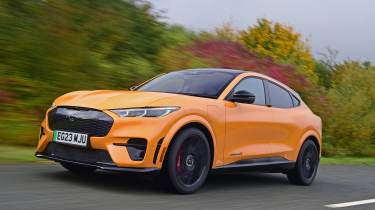
Mercedes Driving Assistance Package Plus combines adaptive cruise control, lane-keeping assistance and automatic overtaking for an extra £1,695. BMW offers a similar system in its models, too, priced at £1,250.
Is Tesla Autopilot safe?
This is the big question, and it’s hard to give a definite answer. Tesla Autopilot is generally regarded as safe, so long as you use it within its capabilities. You need to stay alert and in the driver’s seat, and remember that you may need to take over at a moment’s notice. Your Tesla’s owner’s manual includes an entire section dedicated to Autopilot limitations and warnings, so it’s important to read this before using the system.
Tesla has racked up billions of miles in testing to try and ensure that its cars can handle every eventuality they may face. While there have been some high profile collisions involving Tesla models with Autopilot engaged, thorough investigations are necessary to determine if it was the software at fault, or if Autopilot was used outside Tesla’s recommended stipulations. Autopilot should be safe to use as long as you remain alert and able to take control at all times. Future updates aim to improve the reliability of the system, so the hope is that it will become even safer over time.
Frequently Asked Questions
Tesla Autopilot, Enhanced Autopilot and Full Self-Driving are all legal in the UK as none of these systems are fully autonomous. Fully autonomous driving is currently banned in the UK, although the 2024 Automated Vehicles Act aims to allow the first self-driving vehicles on public roads in 2026.
You can read our reviews of the latest Tesla models, including the Model 3 and Model Y…
Recommended
Most Popular
Tips & advice

Car dashboard warning lights: what does each symbol mean?

Electric car charging stations: public networks, charger types, apps and maps

